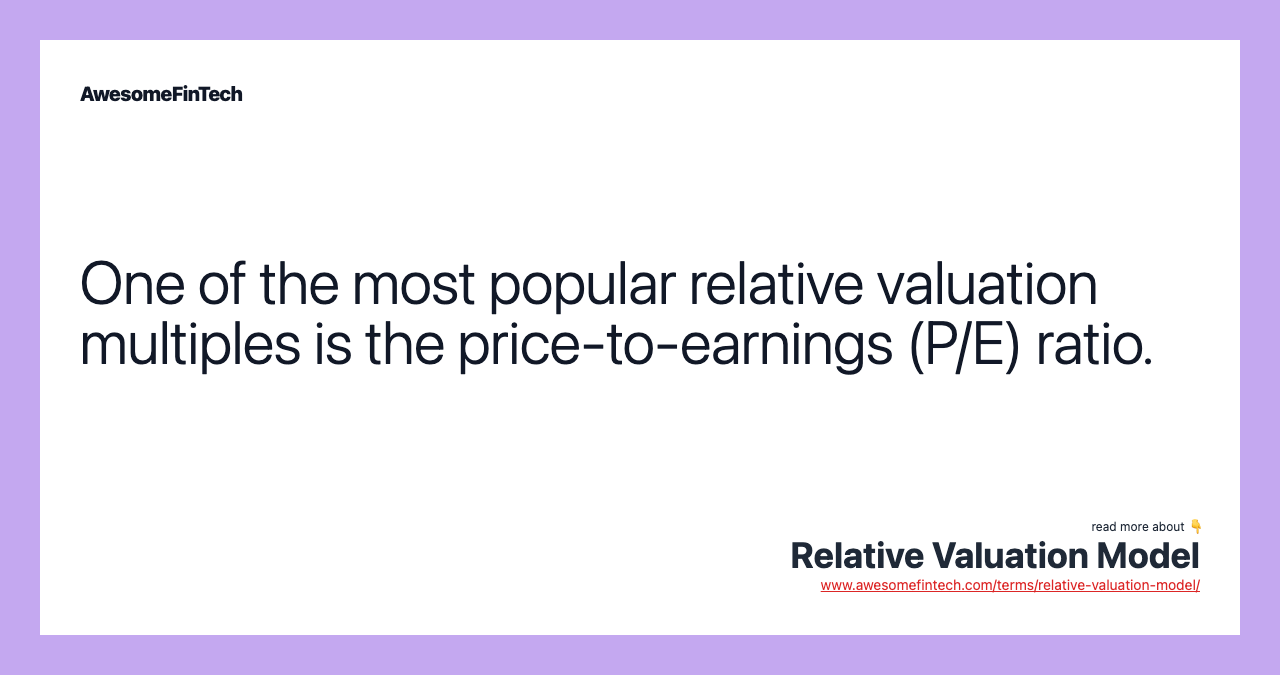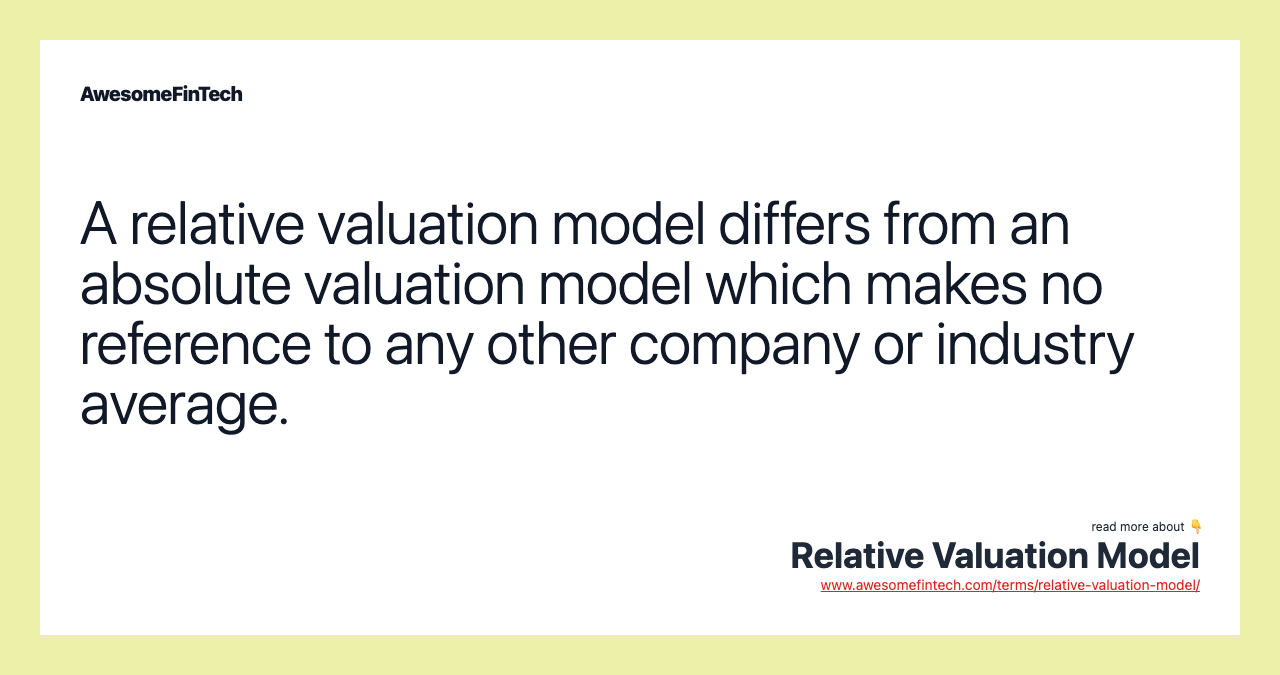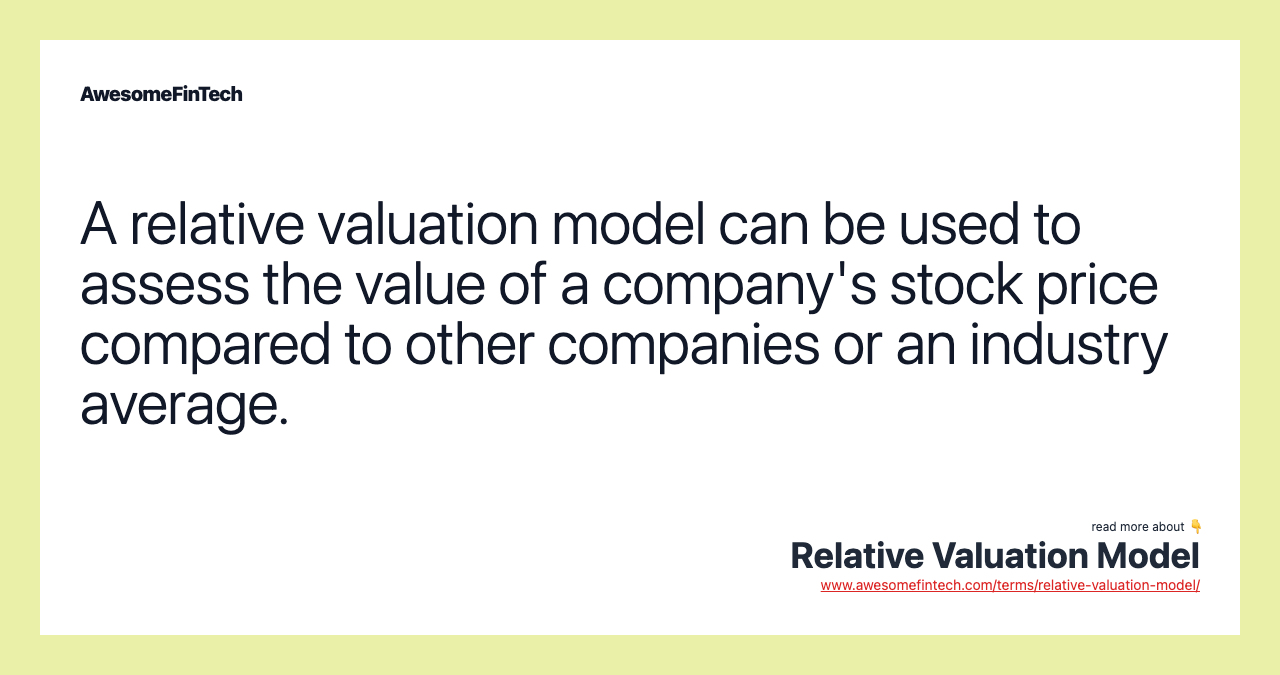Relative Valuation Model
A relative valuation model is a business valuation method that compares a company's value to that of its competitors or industry peers to assess the firm's financial worth. Relative valuation models are an alternative to absolute value models, which try to determine a company's intrinsic worth based on its estimated future free cash flows discounted to their present value, without any reference to another company or industry average. There are many different types of relative valuation ratios, such as price to free cash flow, enterprise value (EV), operating margin, price to cash flow for real estate and price-to-sales (P/S) for retail. For example, if the average P/E for the specialty retail industry is 20x, it means the average price of stock from a company in the industry trades at 20 times its EPS. A relative valuation model can be used to assess the value of a company's stock price compared to other companies or an industry average.

What Is a Relative Valuation Model?
A relative valuation model is a business valuation method that compares a company's value to that of its competitors or industry peers to assess the firm's financial worth. Relative valuation models are an alternative to absolute value models, which try to determine a company's intrinsic worth based on its estimated future free cash flows discounted to their present value, without any reference to another company or industry average. Like absolute value models, investors may use relative valuation models when determining whether a company's stock is a good buy.




Types of Relative Valuation Models
There are many different types of relative valuation ratios, such as price to free cash flow, enterprise value (EV), operating margin, price to cash flow for real estate and price-to-sales (P/S) for retail.
One of the most popular relative valuation multiples is the price-to-earnings (P/E) ratio. It is calculated by dividing stock price by earnings per share (EPS), and is expressed as a company's share price as a multiple of its earnings. A company with a high P/E ratio is trading at a higher price per dollar of earnings than its peers and is considered overvalued. Likewise, a company with a low P/E ratio is trading at a lower price per dollar of EPS and is considered undervalued. This framework can be carried out with any multiple of price to gauge relative market value. Therefore, if the average P/E for an industry is 10x and a particular company in that industry is trading at 5x earnings, it is relatively undervalued to its peers.
Relative Valuation Model vs. Absolute Valuation Model
Relative valuation uses multiples, averages, ratios, and benchmarks to determine a firm's value. A benchmark may be selected by finding an industry-wide average, and that average is then used to determine relative value. An absolute measure, on the other hand, makes no external reference to a benchmark or average. A company's market capitalization, which is the aggregate market value of all of its outstanding shares, is expressed as a plain dollar amount and tells you little about its relative value. Of course, with enough absolute valuation measures in hand across several firms, relative inferences can be drawn.
Special Considerations
Estimating Relative Value of Stock
In addition to providing a gauge for relative value, the P/E ratio allows analysts to back into the price that a stock should be trading at based on its peers. For example, if the average P/E for the specialty retail industry is 20x, it means the average price of stock from a company in the industry trades at 20 times its EPS.
Assume Company A trades for $50 in the market and has an EPS of $2. The P/E ratio is calculated by dividing $50 by $2, which is 25x. This is higher than the industry average of 20x, which means Company A is overvalued. If Company A were trading at 20 times its EPS, the industry average, it would be trading at a price of $40, which is the relative value. In other words, based on the industry average, Company A is trading at a price that is $10 higher than it should be, representing an opportunity to sell.
Because of the importance of developing an accurate benchmark or industry average, it is important to only compare companies in the same industry and market capitalization when calculating relative values.
Related terms:
Absolute Value
Absolute value is a measure of a company's or asset's intrinsic value. read more
Balance Sheet : Formula & Examples
A balance sheet is a financial statement that reports a company's assets, liabilities and shareholder equity at a specific point in time. read more
Bottom-Up Investing
Bottom-up investing is an investment approach that focuses on the analysis of individual stocks and de-emphasizes the significance of macroeconomic cycles. read more
Business Valuation , Methods, & Examples
Business valuation is the process of estimating the value of a business or company. read more
Cash Flow
Cash flow is the net amount of cash and cash equivalents being transferred into and out of a business. read more
Cash Flow Statement & Examples
A cash flow statement is a financial statement that provides aggregate data regarding all cash inflows and outflows a company receives. read more
Discounted Cash Flow (DCF)
Discounted cash flow (DCF) is a valuation method used to estimate the attractiveness of an investment opportunity. read more
Earnings
A company's earnings are its after-tax net income, meaning its profits. Earnings are the main determinant of a public company's share price. read more
Enterprise Value (EV) , Formula, & Examples
Enterprise value (EV) is a measure of a company's total value, often used as a comprehensive alternative to equity market capitalization that includes debt. read more
Earnings Per Share (EPS)
Earnings per share (EPS) is the portion of a company's profit allocated to each outstanding share of common stock. Earnings per share serve as an indicator of a company's profitability. read more